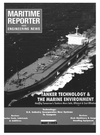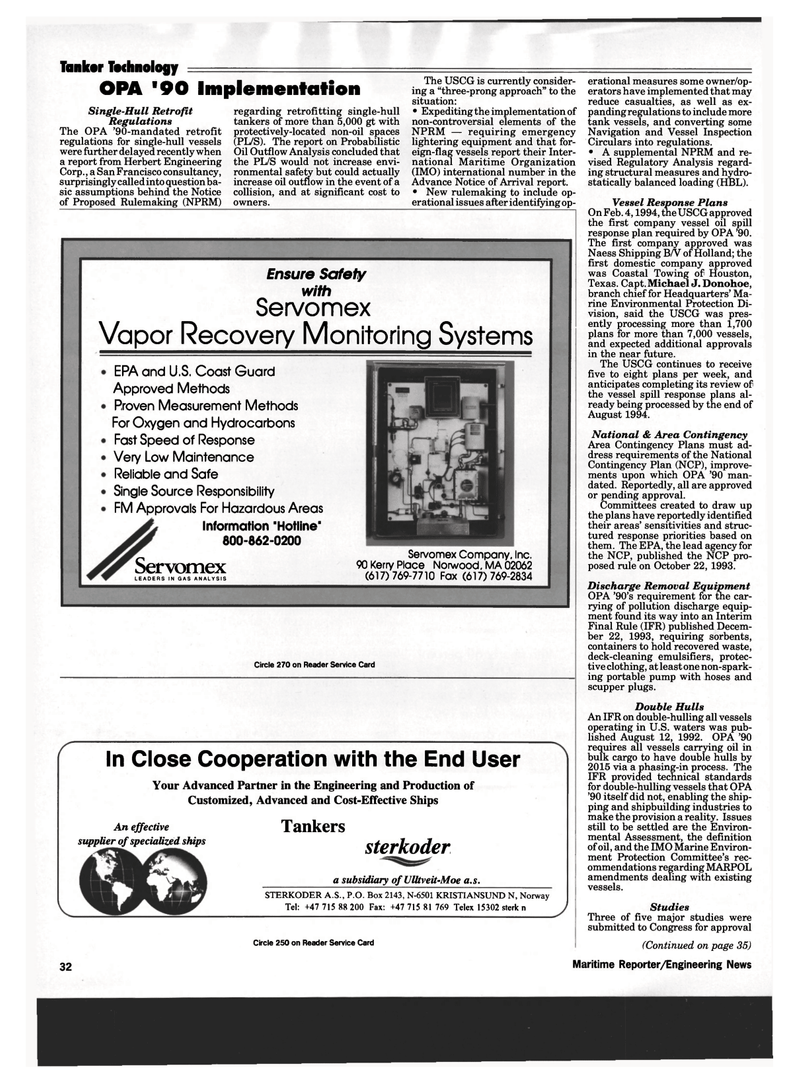
Page 30: of Maritime Reporter Magazine (May 1994)
Read this page in Pdf, Flash or Html5 edition of May 1994 Maritime Reporter Magazine
Tanker Technology
OPA '90 Implementation
Single-Hull Retrofit
Regulations
The OPA '90-mandated retrofit regulations for single-hull vessels were further delayed recently when a report from Herbert Engineering
Corp., a San Francisco consultancy, surprisingly called into question ba- sic assumptions behind the Notice of Proposed Rulemaking (NPRM) regarding retrofitting single-hull tankers of more than 5,000 gt with protectively-located non-oil spaces (PL/S). The report on Probabilistic
Oil Outflow Analysis concluded that the PL/S would not increase envi- ronmental safety but could actually increase oil outflow in the event of a collision, and at significant cost to owners.
The USCG is currently consider- ing a "three-prong approach" to the situation: • Expediting the implementation of non-controversial elements of the
NPRM — requiring emergency lightering equipment and that for- eign-flag vessels report their Inter- national Maritime Organization (IMO) international number in the
Advance Notice of Arrival report. • New rulemaking to include op- erational issues after identifying op-
Ensure Safety with Servomex
Vapor Recovery Monitoring Systems
EPA and U.S. Coast Guard
Approved Methods
Proven Measurement Methods
For Oxygen and Hydrocarbons
Fast Speed of Response
Very Low Maintenance
Reliable and Safe
Single Source Responsibility
FM Approvals For Hazardous Areas
Information "Hotline" 800-862-0200
Servomex
LEADERS IN GAS ANALYSIS
Servomex Company, Inc. 90 Kerry Place Norwood. MA 02062 (617)769-7710 Fax (617)769-2834
Circle 270 on Reader Service Card
In Close Cooperation with the End User
Your Advanced Partner in the Engineering and Production of
Customized, Advanced and Cost-Effective Ships
An effective supplier of specialized ships
Tankers sterkoder a subsidiary of Ulltveit-Moe a.s.
STERKODER A.S., P.O. Box 2143, N-6501 KRISTIANSUND N, Norway
Tel: +47 715 88 200 Fax: +47 715 81 769 Telex 15302 sterk n
Circle 250 on Reader Service Card erational measures some owner/op- erators have implemented that may reduce casualties, as well as ex- panding regulations to include more tank vessels, and converting some
Navigation and Vessel Inspection
Circulars into regulations. • A supplemental NPRM and re- vised Regulatory Analysis regard- ing structural measures and hydro- statically balanced loading (HBL).
Vessel Response Plans
On Feb. 4,1994, the USCG approved the first company vessel oil spill response plan required by OPA '90.
The first company approved was
Naess Shipping B/V of Holland; the first domestic company approved was Coastal Towing of Houston,
Texas. Capt. Michael J. Donohoe, branch chief for Headquarters' Ma- rine Environmental Protection Di- vision, said the USCG was pres- ently processing more than 1,700 plans for more than 7,000 vessels, and expected additional approvals in the near future.
The USCG continues to receive five to eight plans per week, and anticipates completing its review of the vessel spill response plans al- ready being processed by the end of
August 1994.
National & Area Contingency
Area Contingency Plans must ad- dress requirements of the National
Contingency Plan (NCP), improve- ments upon which OPA '90 man- dated. Reportedly, all are approved or pending approval.
Committees created to draw up the plans have reportedly identified their areas' sensitivities and struc- tured response priorities based on them. The EPA, the lead agency for the NCP, published the NCP pro- posed rule on October 22, 1993.
Discharge Removal Equipment
OPA '90's requirement for the car- rying of pollution discharge equip- ment found its way into an Interim
Final Rule (IFR) published Decem- ber 22, 1993, requiring sorbents, containers to hold recovered waste, deck-cleaning emulsifiers, protec- tive clothing, at least one non-spark- ing portable pump with hoses and scupper plugs.
Double Hulls
An IFR on double-hulling all vessels operating in U.S. waters was pub- lished August 12, 1992. OPA '90 requires all vessels carrying oil in bulk cargo to have double hulls by 2015 via a phasing-in process. The
IFR provided technical standards for double-hulling vessels that OPA '90 itself did not, enabling the ship- ping and shipbuilding industries to make the provision a reality. Issues still to be settled are the Environ- mental Assessment, the definition of oil, and the IMO Marine Environ- ment Protection Committee's rec- ommendations regarding MARPOL amendments dealing with existing vessels.
Studies
Three of five major studies were submitted to Congress for approval (Continued on page 35) 32 Maritime Reporter/Engineering News

 29
29

 31
31
